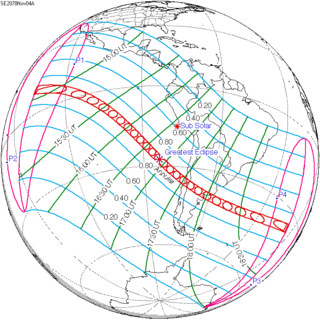Solar eclipse of November 4, 2078 Contents Related eclipses References External links Navigation menu27°48′S 83°18′W / 27.8°S 83.3°W / -27.8; -83.39684"Solar- and Lunar-Eclipse Predictions from Antiquity to the Present"Earth visibility chart and eclipse statisticsGoogle interactive mapBesselian elementseexpanding ite
Annular solar eclipses2078 in science21st-century solar eclipsesSolar eclipses by timeSolar eclipse stubs
solar eclipsesolar eclipseMoonEarthSunapparent diameterannulussemester seriesnodestritossynodic monthsanomalistic month
| Solar eclipse of November 4, 2078 | |
|---|---|
 Map | |
| Type of eclipse | |
| Nature | Annular |
| Gamma | -0.2285 |
| Magnitude | 0.9255 |
| Maximum eclipse | |
| Duration | 509 sec (8 m 29 s) |
| Coordinates | 27°48′S 83°18′W / 27.8°S 83.3°W / -27.8; -83.3 |
| Max. width of band | 287 km (178 mi) |
| Times (UTC) | |
| Greatest eclipse | 16:55:44 |
| References | |
| Saros | 144 (20 of 70) |
| Catalog # (SE5000) | 9684 |
An annular solar eclipse will occur on Friday, November 4, 2078. A solar eclipse occurs when the Moon passes between Earth and the Sun, thereby totally or partly obscuring the image of the Sun for a viewer on Earth. An annular solar eclipse occurs when the Moon's apparent diameter is smaller than the Sun's, blocking most of the Sun's light and causing the Sun to look like an annulus (ring). An annular eclipse appears as a partial eclipse over a region of the Earth thousands of kilometres wide. The path of annularity will cross Pacific Ocean, South America, and Atlantic Ocean.
Contents
1 Related eclipses
1.1 Solar eclipses 2076-2079
1.2 Tritos series
2 References
3 External links
Related eclipses
Solar eclipses 2076-2079
This eclipse is a member of a semester series. An eclipse in a semester series of solar eclipses repeats approximately every 177 days and 4 hours (a semester) at alternating nodes of the Moon's orbit.[1]
| 119 | June 1, 2076  Partial | 124 | November 26, 2076  Partial |
| 129 | May 22, 2077  Total | 134 | November 15, 2077  Annular |
| 139 | May 11, 2078  Total | 144 | November 4, 2078  Annular |
| 149 | May 1, 2079  Total | 154 | October 24, 2079  Annular |
Tritos series
This eclipse is a part of a tritos cycle, repeating at alternating nodes every 135 synodic months (≈ 3986.63 days, or 11 years minus 1 month). Their appearance and longitude are irregular due to a lack of synchronization with the anomalistic month (period of perigee), but groupings of 3 tritos cycles (≈ 33 years minus 3 months) come close (≈ 434.044 anomalistic months), so eclipses are similar in these groupings.
| Series members between 1801 and 2100 | |||
|---|---|---|---|
| December 21, 1805 (Saros 119) | November 19, 1816 (Saros 120) | October 20, 1827 (Saros 121) | |
| September 18, 1838 (Saros 122) | August 18, 1849 (Saros 123) | July 18, 1860 (Saros 124) | |
| June 18, 1871 (Saros 125) | May 17, 1882 (Saros 126) | April 16, 1893 (Saros 127) | |
 March 17, 1904 (Saros 128) |  February 14, 1915 (Saros 129) |  January 14, 1926 (Saros 130) | |
 December 13, 1936 (Saros 131) |  November 12, 1947 (Saros 132) |  October 12, 1958 (Saros 133) | |
 September 11, 1969 (Saros 134) |  August 10, 1980 (Saros 135) |  July 11, 1991 (Saros 136) | |
 June 10, 2002 (Saros 137) |  May 10, 2013 (Saros 138) |  April 8, 2024 (Saros 139) | |
 March 9, 2035 (Saros 140) |  February 5, 2046 (Saros 141) |  January 5, 2057 (Saros 142) | |
 December 6, 2067 (Saros 143) |  November 4, 2078 (Saros 144) |  October 4, 2089 (Saros 145) | |
 September 4, 2100 (Saros 146) | |||
References
^ van Gent, R.H. "Solar- and Lunar-Eclipse Predictions from Antiquity to the Present". A Catalogue of Eclipse Cycles. Utrecht University. Retrieved 6 October 2018..mw-parser-output cite.citationfont-style:inherit.mw-parser-output .citation qquotes:"""""""'""'".mw-parser-output .citation .cs1-lock-free abackground:url("//upload.wikimedia.org/wikipedia/commons/thumb/6/65/Lock-green.svg/9px-Lock-green.svg.png")no-repeat;background-position:right .1em center.mw-parser-output .citation .cs1-lock-limited a,.mw-parser-output .citation .cs1-lock-registration abackground:url("//upload.wikimedia.org/wikipedia/commons/thumb/d/d6/Lock-gray-alt-2.svg/9px-Lock-gray-alt-2.svg.png")no-repeat;background-position:right .1em center.mw-parser-output .citation .cs1-lock-subscription abackground:url("//upload.wikimedia.org/wikipedia/commons/thumb/a/aa/Lock-red-alt-2.svg/9px-Lock-red-alt-2.svg.png")no-repeat;background-position:right .1em center.mw-parser-output .cs1-subscription,.mw-parser-output .cs1-registrationcolor:#555.mw-parser-output .cs1-subscription span,.mw-parser-output .cs1-registration spanborder-bottom:1px dotted;cursor:help.mw-parser-output .cs1-ws-icon abackground:url("//upload.wikimedia.org/wikipedia/commons/thumb/4/4c/Wikisource-logo.svg/12px-Wikisource-logo.svg.png")no-repeat;background-position:right .1em center.mw-parser-output code.cs1-codecolor:inherit;background:inherit;border:inherit;padding:inherit.mw-parser-output .cs1-hidden-errordisplay:none;font-size:100%.mw-parser-output .cs1-visible-errorfont-size:100%.mw-parser-output .cs1-maintdisplay:none;color:#33aa33;margin-left:0.3em.mw-parser-output .cs1-subscription,.mw-parser-output .cs1-registration,.mw-parser-output .cs1-formatfont-size:95%.mw-parser-output .cs1-kern-left,.mw-parser-output .cs1-kern-wl-leftpadding-left:0.2em.mw-parser-output .cs1-kern-right,.mw-parser-output .cs1-kern-wl-rightpadding-right:0.2em
External links
Earth visibility chart and eclipse statistics Eclipse Predictions by Fred Espenak, NASA/GSFC- Google interactive map
- Besselian elements
This Solar eclipse-related article is a stub. You can help Wikipedia by expanding it. |



